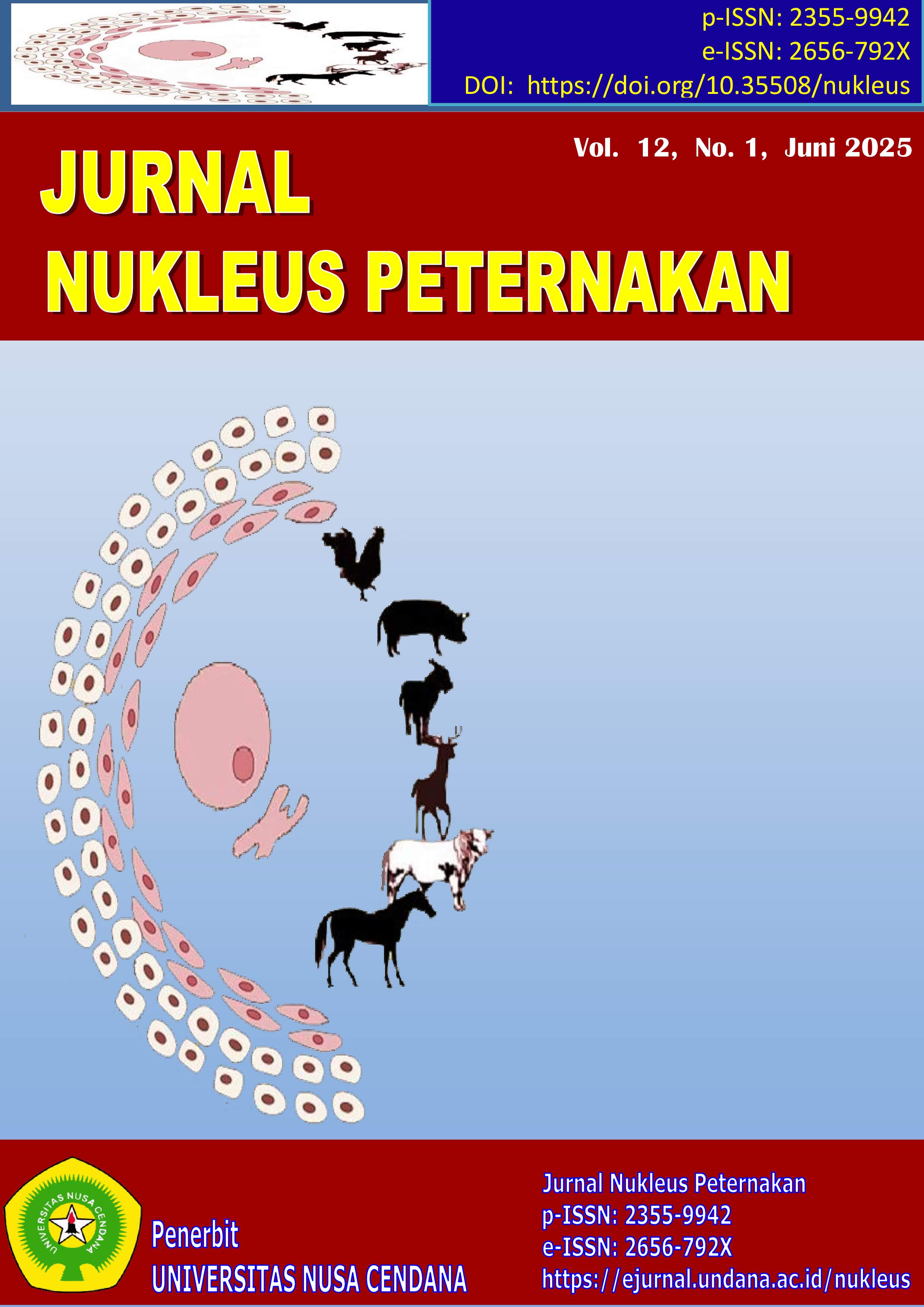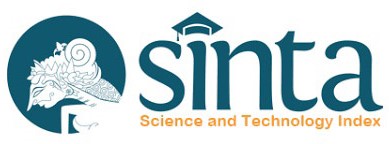RESPON KANDUNGAN ISOFLAVON DAIDZEINPADA LEGUM Alysicarpus vaginalis TERHADAP VARIASI DOSIS PUPUK FOSFOR (Response of Daidzein Isoflavone Content in Alysicarpus vaginalis Legume to Variations in Phosphorus Fertilizer Doses)
Abstract
This study is grounded in the significance of daidzein as a phytoestrogen with potential to enhance livestock reproductive performance, while its availability in conventional feed ingredients remains limited. Alysicarpus vaginalis is a local legume species exhibiting relatively high phenolic and flavonoid compounds, including isoflavones, making this information crucial for developing phytogenic based functional feed. This research aimed to evaluate the effect of varying phosphorus fertilizer doses on daidzein isoflavone content in Alysicarpus vaginalis. An experimental study was conducted using a Completely Randomized Design (CRD) with five phosphorus dose treatments (0, 10, 20, 30, and 40 kg P/ha) and three replications. The methodology included: (1) isoflavone extraction via 70% ethanol maceration, (2) extract concentration using a rotary evaporator, and (3) quantitative analysis of daidzein content in phosphorus fertilized Alysicarpus vaginalis using High-Performance Liquid Chromatography (HPLC). Increasing phosphorus doses (0–40 kg P/ha) significantly (P<0.05) elevated daidzein content from 0.0922 g/100 g sample (control, 0 kg P/ha) to 2.9978 g/100 g sample at the highest dose (40 kg P/ha). Statistical analysis revealed a strong positive correlation between phosphorus dosage and daidzein accumulation (R² = 0.985). Phosphorus fertilizer application enhances daidzein production in Alysicarpus vaginalis, implying potential for functional feed development to support livestock health and productivity.
Downloads
References
Anguraj Vadivel, A.K., McDowell, T., Renaud, J.B., & Dhaubhadel, S. 2021. A combinatorial action of GmMYB176 and GmbZIP5 controls isoflavonoid biosynthesis in soybean (Glycine max). Commun. Biol. 4: 356. https://doi.org/10.1038/s42003–021-01889–6
Anguraj Vadivel, A.K., Renaud, J., Kagale, S., & Dhaubhadel, S. 2019. GmMYB176 regulates multiple steps in isoflavonoid biosynthesis in soybean. Front. Plant Sci. 10:562. https://doi.org/10.3389/fpls.2019.00562
Araya-Cloutier, C,, den Besten, H.M., Aisyah, S., Gruppen, H., & Vincken, J.P. 2017. The position of prenylation of isoflavonoids and stilbenoids from legumes (Fabaceae) modulates the antimicrobial activity against Gram positive pathogens. Food Chem. 226: 193–201. https://doi.org/10.1016/j.foodchem.2017.01.026
Arya, P., & Mehta, J.P. 2017. Antioxidant Potential of Himalayan Medicinal Plants Angelica glauca, Alysicarpus vaginalis and Peristrophe bicalyculata. International Journal of Current Microbiology and Applied Sciences. 6: 1892–1901. https://doi.org/10.20546/ijcmas.2017.607.226
Banasiak, J., Biala, W., Staszkow, A., Swarcewicz, B., Kepczynska, E., Figlerowicz, M., & Jasinski, M. 2013. A Medicago truncatula ABC transporter belonging to subfamily G modulates the level of isoflavonoids. J. Exp. Bot. 64: 1005–1015. https://doi.org/10.1093/jxb/ers380
Bassi, D., Menossi, M., & Mattiello, L. 2018. Nitrogen supply influences photosynthesis establishment along the sugarcane leaf. Scientific Reports. 8(1): 1–13. https://doi.org/10.1038/s41598-018-20653-1
Biala-Leonhard, W., Zanin, L., Gottardi, S., de Brito Francisco, R., Venuti, S., Valentinuzzi, F. Mimmo T., Cesco, S., Bassin, B., Martinoia, E., Pinton, R., Jasiński, M., & Tomasi, N. 2021. Identification of an isoflavonoid transporter required for the nodule establishment of the rhizobium-fabaceae symbiotic interaction. Front. Plant Sci. 12. https://doi.org/10.3389/fpls.2021.758213
Bustamante-Rangel, M., Delgado-Zamarreño, M.M., Pérez-Martín, L., Rodríguez-Gonzalo, E., & Domínguez-Álvarez, J. 2018. Analysis of Isoflavones in Foods. Comprehensive Reviews in Food Science and Food Safety. 17: 391–411. https://doi.org/10.1111/1541-4337.12325
Chang, Y.N., Zhu, C., Jiang, J., Zhang, H., Zhu, J.K., & Duan, C.G. 2020. Epigenetic regulation in plant abiotic stress responses. J. Integr. Plant. Biol. 62: 563-580. https://doi.org/10.1111/jipb.12901
Daning, D.R.A., & Foekh. 2018. Evaluasi produksi dan kualitas nutrisi pada bagian daun dan kulit kayu Calliandra callotirsus dan Gliricidia sepium. Sains Peternakan: Jurnal Penelitian Ilmu Peternakan. 16(1): 7-11.
Dastmalchi, M., Chapman, P., Yu, J., Austin, R.S., & Dhaubhadel, S. 2017. Transcriptomic evidence for the control of soybean root isoflavonoid content by regulation of overlapping phenylpropanoid pathways. BMC Genomics. 18: 70. https://doi.org/10.1186/s12864-016-3463-y
Deng, B., Li, Y., Xu, D., Ye, Q., & Liu, G. 2019. Nitrogen availability alters flavonoid accumulation in Cyclocarya paliurus via the effects on the internal carbon/nitrogen balance. Scientific Reports. 9(1): 1–9. https://doi.org/10.1038/s41598-019-38837-8
Dewhurst, R.J., Fisher, W.J., Tweed, J.K.S., & Wilkins, R.J. 2003. Comparison of grass and legume silages for milk production. 1. Production responses with different levels of concentrate. J. Dairy Sci. 86: 2598-2611. https://doi.org/10.3168/jds.S0022-0302(03)73855-7
Dixon, R.A., Harrison, M.J., & Paiva, N.L. 1995. The isoflavonoid phytoalexin pathway: from enzymes to genes to transcription factors. Physiologia Plantarum. 93: 385–392. https://doi.org/10.1111/j.1399-3054.1995.tb02243.x
Dixon, R.A. 1999. Isoflavonoids: biochemistry, molecular biology and biological functions. Compr. Natural Products Chem. 1: 773–823. https://doi.org/10.1016/B978-0-08-091283-7.00030-8
Dong, N.Q., & Lin, H.X. 2021. Contribution of phenylpropanoid metabolism to plant development and plant-environment interactions. J. Integr. Plant Biol. 63: 180–209. https://doi.org/10.1111/jipb.13054
Etxeberria, U., Fernández-Quintela, A., Milagro, F.I., Aguirre, L., Martínez, J.A., & Portillo, M.P. 2013. Impact of Polyphenols and Polyphenol-Rich Dietary Sources on Gut Microbiota Composition. J. Agric. Food Chem. 61: 9517–9533. https://doi.org/10.1021/jf402506c
Farag, M.A., Huhman, D.V., Dixon, R.A., & Sumner, L.W. 2008. Metabolomics reveals novel pathways and differential mechanistic and elicitor-specific responses in phenylpropanoid and isoflavonoid biosynthesis in Medicago truncatula cell cultures. Plant Physiol. 146: 387–402. https://doi.org/10.1104/pp.107.108431
Foudah, A.I., & Abdel-Kader, M.S. 2017. Isoflavonoids. Flavonoids - From Biosynthesis to Human Health. InTech. https://doi.org/10.5772/intechopen.68701
García-Calderón, M., Pérez-Delgado, C.M., Palove-Balang, P., Betti, M., & Márquez, A.J. 2020. Flavonoids and Isoflavonoids Biosynthesis in the Model Legume Lotus japonicus; Connections to Nitrogen Metabolism and Photorespiration. Plants. 9(6): 774. https://doi.org/10.3390/plants9060774
Guo-zhen, J., & Li, W. 2014. Effect of Daidzein on Ileum Microflora Biodiversity in Hy-Line Variety Brown Layers. J. Northeast Agric. Univ. 21: 31–36. https://doi.org/10.1016/S1006-8104(15)30017-9
Heimler, D., Romani, A., & Ieri, F. 2017. Plant polyphenol content, soil fertilization and agricultural management: A review. Eur. Food Res. Technol. 243: 1107-1115. https://doi.org/10.1007/s00217-016-2826-6
Hu, B., Jiang, Z., Wang, W., Qiu, Y., Zhang, Z., Liu, Y., Li, A., Gao, X., Liu, L., & Qian, Y. 2019. Nitrate–NRT1. 1B–SPX4 cascade integrates nitrogen and phosphorus signalling networks in plants. Nature Plants 5(4): 401-413. https://doi.org/10.1038/s41477-019-0420-1
Jang, D., Jung, Y.S., Kim, M.S., Oh, S.E., Nam, T.G., & Kim, D.O. 2019. Developing and Validating a Method for Separating Flavonoid Isomers in Common Buckwheat Sprouts Using HPLC-PDA. Foods. 8(11): 549. https://doi.org/0.3390/foods8110549
Jelantik, I.G.N., Tiba, N.T., & Penu, C.L. 2019. Memanfaatkan Padang Penggembalaan Alam Untuk Meningkatkan Populasi dan Produktifitas Ternak Sapi di Daerah Lahan Kering. Ponorogo: Myria Publisher.
Kaufman, P.B., Duke, J.A., Brielmann, H., Boik, J., & Hoyt, J.E. 1997. A comparative survey of leguminous plants as sources of the isoflavones, genistein and daidzein: implications for human nutrition and health. J. Altern. Complement Med. 3: 7–12. https://doi.org/10.1089/acm.1997.3.7
Kougan, G.B., Tabopda, T., Kuete, V., & Verpoorte, V. 2013. Simple phenols, phenolic acids, and related esters from the medicinal plants of africa. In Medicinal Plant Research in Africa. 225–249. https://doi.org/10.1016/B978-0-12-405927-6.00006-0
Król, B., Seczyk, Ł., Kołodziej, B., & Paszko, T. 2020. Biomass production, active substance content, and bioaccessibility of Greek oregano (Origanum vulgare ssp. hirtum (Link) Ietswaart) following the application of nitrogen. Ind. Crop. Prod. 148: 112271. https://doi.org/10.1016/j.indcrop.2020.112271
Liu, D.Y., He, S.J., Jin, E.H., Liu, S.Q., Tang, Y.G., Li, S.H., & Zhong, L.T. 2013. Effect of daidzein on production performance and serum antioxidative function in late lactation cows under heat stress. Livest. Sci. 152: 16–20. https://doi.org/10.1016/j.livsci.2012.12.003
Liu, H.Y., & Zhang, C.Q. 2008. Effects of daidzein on messenger ribonucleic Acid expression of gonadotropin receptors in chicken ovarian follicles. Poult. Sci. 87: 541–545. https://doi.org/10.3382/ps.2007-00274
Liu, Q., Liu, Y., Li, G., Savolainen, O., Chen, Y., & Nielsen, J. 2021. De novo biosynthesis of bioactive isoflavonoids by engineered yeast cell factories. Nat. Commun. 12(1): 6085. https://doi.org/10.1038/s41467-021-26361-1
Mohanty, I., Senapati, M.R., Jena, D., & Behera, P.C. 2014. Ethnoveterinary importance of herbal galactogogues—A review. Vet. World. 7: 325–330. https://doi.org/10.14202/vetworld.2014.325-330
Moorby, J.M., Fraser, M.D., Theobald, V.J., Wood, J.D., & Haresign, W. 2004. The effect of red clover formononetin content on live-weight gain, carcass characteristics and muscle equol content of finishing lambs. Anim. Sci. 79: 303–313. https://doi.org/10.1017/S1357729800090160
Muro-Villanueva, F., Mao, X., & Chapple, C. 2019. Linking phenylpropanoid metabolism, lignin deposition, and plant growth inhibition. Curr. Opin. Biotechnol. 56: 202–208. https://doi.org/10.1016/j.copbio.2018.12.008
Ogunsuyi, O.B., Ademiluyi, A.O., & Oboh, G. 2020. Solanum leaves extracts exhibit antioxidant properties and inhibit monoamine oxidase and acetylcholinesterase activities (in vitro) in Drosophila melanogaster. Journal of Basic and Clinical and Pharmacology. 31: 1–13. https://doi.org/10.1515/jbcpp-2019-0256
Olesinska, K., Sugier, D., & Kaczmarski, Z. 2021. Yield and chemical composition of raw material from meadow Arnica (Arnica chamissonis Less.) depending on soil conditions and nitrogen fertilization. Agriculture. 11: 810. https://doi.org/10.3390/agriculture11090810
Sari, Y.C., Nanda, S., Mardiah, F.P., & Yunita, R. 2022. Pengembangan leguminosa Indigofera sebagai pakan ternak di Nagari Batu Payung Kecamatan Lareh Sago Halaban Kabupaten Lima Puluh Kota. Buletin Ilmiah Magari Membangun. 5(2): 108-118.
Sarkar, F.H., & Li, Y. 2003. Soy isoflavones and cancer prevention. Cancer Invest. 21(5): 744–57. https://doi.org/10.1081/cnv-120023773
Speijers, M.H.M., Fraser, M.D., Theobald, V.J., & Haresign, W. 2005. Effects of ensiled forage legumes on performance of store finishing lambs. Anim. Feed Sci. Technol. 120: 203-216. https://doi.org/10.1016/j.anifeedsci.2005.02.027
Sriagtula, R., & Sowmen, S. 2018. Evaluasi pertumbuhan dan produktivitas sorgum mutan Brown Midrib (Sorghum bicolor L. Moench) fase pertumbuhan berbeda sebagai pakan hijauan pada musim kemarau di tanah ultisol. Jurnal Peternakan Indonesia. 20(2): 130-144.
Steel, R.G.D., & Torrie, J.H. 1995. Pinsip Prosedur Statistika. Jakarta: PT. Gramedia Pustaka Utama.
Su, L., Liu, S., Liu, X., Zhang, B., Li, M., Zeng, L., & Li, L. 2021. Transcriptome profiling reveals histone deacetylase 1 gene overexpression improves flavonoid, isoflavonoid, and phenylpropanoid metabolism in Arachis hypogaea hairy roots. PeerJ. 9: e10976. https://doi.org/10.7717/peerj.10976
Suherman, D., & Herdiawan, I. 2015. Tanaman legum pohon Desmodium rensonil sebagai tanaman pakan ternak bermutu. Pastura. 4(2): 100-104.
Sukumaran, A., McDowell, T., Chen, L., Renaud, J., & Dhaubhadel, S. 2018. Isoflavonoid-specific prenyltransferase gene family in soybean: GmPT01, a pterocarpan 2-dimethylallyltransferase involved in glyceollin biosynthesis. Plant J. 96: 966-981. https://doi.org/10.1111/tpj.14083
Sulieman, S., & Tran, L.S. 2014. Symbiotic nitrogen fixation in legume nodules: metabolism and regulatory mechanisms. Int. J. Mol. Sci. 15(11): 19389–93. https://doi.org/10.3390/ijms151119389
Sulieman, S., & Tran, L.S. 2015. Phosphorus homeostasis in legume nodules as an adaptive strategy to phosphorus deficiency. Plant Sci. 239: 36-43. https://doi.org/10.1016/j.plantsci.2015.06.018
Suryaningsih, Y. 2022. Penerapan teknologi silase untuk mengatasi keterbatasan hijauan pakan ternak pada musim kemarau di Desa Arjasa Kecamatan Arjasa Kabupaten Situbondo. Mimbar Integritas: Jurnal Pengabdian. 1(2): 279–289.
Sutaryono, Y.A.S., & Sari, N.H. 2023. Introduksi pemanfaatan legum lamtoro tarramba (Leucaena leucocephala cv. tarramba) sebagai pakan sumber protein pada kelompok peternak sapi sambik elen Kecamatan Bayan Kabupaten Lombok Utara. Jurnal Pengabdian Magister Pendidikan IPA. 6(2): 296–301.
Tiscione, D., Gallelli, L., Tamanini, I., Luciani, L.G., Verze, P., Palmieri, A., Mirone, V., Bartoletti, R., Malossini, G., & Cai, T. 2017. Daidzein plus isolase associated with zinc improves clinical symptoms and quality of life in patients with LUTS due to benign prostatic hyperplasia: results from a phase I-II study. Arch. Ital. Urol. Androl. 89(1): 12–16. https://doi.org/10.4081/aiua.2017.1.12
Vance, C.P., Uhde-Stone, C., & Allan, D.L. 2003. Phosphorus acquisition and use: critical adaptations by plants for securing a nonrenewable resource. New Phytol. 157(3): 423–447. https://doi.org/10.1046/j.1469-8137.2003.00695.x
Vanhatalo, A., Kuoppala, K., Toivonen, V., & Shingfield, K.J. 2007. Effects of forage species and stage of maturity on bovine milk fatty acid composition. Eur. J. Lipid Sci. Technol. 109: 856–867. https://doi.org/10.1002/ejlt.200700023
Veitch, N.C. 2013. Isoflavonoids of the leguminosae. Nat. Prod. Rep. 30(7): 988–1027. https://doi.org/10.1039/c3np70024k
Vitale, D.C., Piazza, C., Melilli, B., Drago, F., & Salomone, S. 2013. Isoflavones: estrogenic activity, biological effect and bioavailability. Eur. J. Drug. Metab. Pharmacokinet. 38(1): 15–25. https://doi.org/10.1007/s13318-012-0112-y
Wang, X., Li, C., Zhou, C., Li, J., & Zhang, Y. 2017. Molecular characterization of the C-glucosylation for puerarin biosynthesis in Pueraria lobata. Plant J. 90: 535–546. https://doi.org/10.1111/tpj.13510
Wang, X., Zhang, J., Lu, X., Bai, Y., & Wang, G. 2023. Two diversities meet in the rhizosphere: root specialized metabolites and microbiome. J. Genet. Genomics. https://doi.org/10.1016/j.jgg.2023.10.004
Watanabe, S., Yamada, R., Kanetake, H., Kaga, A., & Anai, T. 2019. Identification and characterization of a major QTL underlying soybean isoflavone malonylglycitin content. Breed Sci. 69(4): 564–572. https://doi.org/10.1270/jsbbs.19027
Yadav, V., Wang, Z., Wei, C., Amo, A., Ahmed, B., Yang, X., & Zhang, X. 2020. Phenylpropanoid pathway engineering: an emerging approach towards plant defense. Pathogens. 9: 312. https://doi.org/10.3390/pathogens9040312
Zhang, J., Wang, X., & Xu, T. 2009. Elemental selenium at nano size (Nano-Se) as a potential chemopreventive agent with reduced risk of selenium toxicity: comparison with se-methylselenocysteine in mice. Toxicol Sci. 101(1): 22-31. https://doi.org/10.1093/toxsci/kfm221
Copyright (c) 2025 JURNAL NUKLEUS PETERNAKAN

This work is licensed under a Creative Commons Attribution-NonCommercial-NoDerivatives 4.0 International License.
 Prihutomo Suharto(1*)
Prihutomo Suharto(1*)





.jpg)





